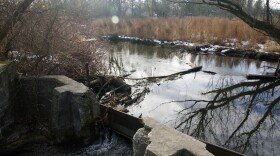Like many of us, Western Michigan University English professor Nic Witschi is working remotely during the pandemic. But normally he commutes on foot, walking up busy Stadium Drive from Rambling Road. In the 20 years since he started making the trek, he’s noticed something odd about the surface.
Beginning near Howard Street and continuing southwest for about a mile, the outer lanes of Stadium Drive are paved with concrete. But the inner three lanes have an asphalt surface.
“Why is Stadium Drive, at least from Howard to somewhere around Sparkle Buggy or Seelye Ford, differently paved depending on what lane you’re looking at?” Witschi asked in a recent virtual meeting.
Nick Schirripa, spokesman for the southwest region of the Michigan Department of Transportation said Nic Witschi’s observation surprised him. He knows Stadium Drive well. “I’ve driven it every week for the better part of 40 years and never noticed” the different pavement, he said.
Schirripa did some research and he’s going to tell us what the pavement reveals about Stadium Drive.
Schirripa said a few years ago the state had its own questions about the road, so it dug into the history. MDOT found Stadium Drive wasn’t always five lanes wide.
“What we discovered was, originally that was a three-lane road,” Schirripa said. “And it was, the top course is about eight, eight and a half inches of concrete.”
That is, the middle three lanes of Stadium Drive are older than the outer lanes. And underneath the asphalt those middle three lanes are concrete just like the ones on the outside. Here’s why the inner and outer lanes now have different surfaces. Schirripa says when the state widened the road roughly 50 years ago, it made the new, outer lanes a couple inches taller than the old ones.
“Essentially when they added those two lanes they built like a concrete tray, looks like a dinner tray, with a little bit of asphalt through those three lanes.”
The asphalt in the middle is there to bring the older, shorter lanes level with the new ones. Why did the designers of the new lanes make them taller?
“No idea why. There’s no record of why they did it,” Schirripa said.
He added they may have assumed the engineers of the future would pick one surface or another, someday when they redid the road. But so far this portion of Stadium Drive has been maintained with two different surfaces, hinting at the road’s past.
“It really kind of creates a little bit of fun history,” Schirripa said. “That’s really why you see what you see, is that’s how it was built when it was expanded some 50 years ago.”
Nic Witschi, who noticed the contrasting lanes as he walked to work, said he didn’t realize the outer lanes were newer. “Can I just say, that is so cool!”
“May I just say that you’re the first person in a decade to respond that way to anything I’ve said out loud, so thank you. It really was kind of fascinating,” Schirripa said.
Schirripa has one more fun fact for pavement watchers. On the highway, he said, look for a shift from asphalt to concrete when going under a bridge. That’s to make sure the height of the bridge doesn’t change. Schirripa says asphalt’s not a great choice because cold weather and moisture can raise the surface by several inches.
“If you do see asphalt it’s asphalt over a concrete base,” he added.





